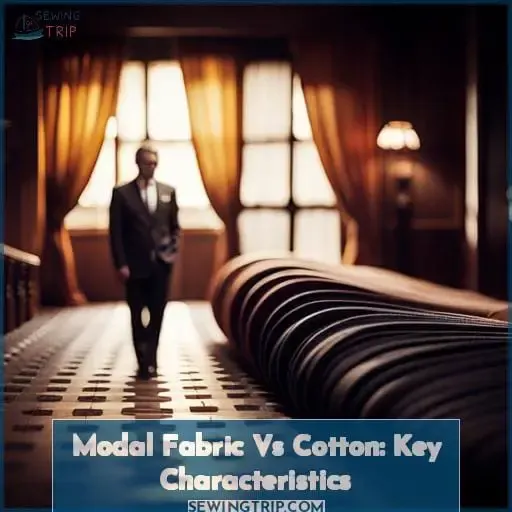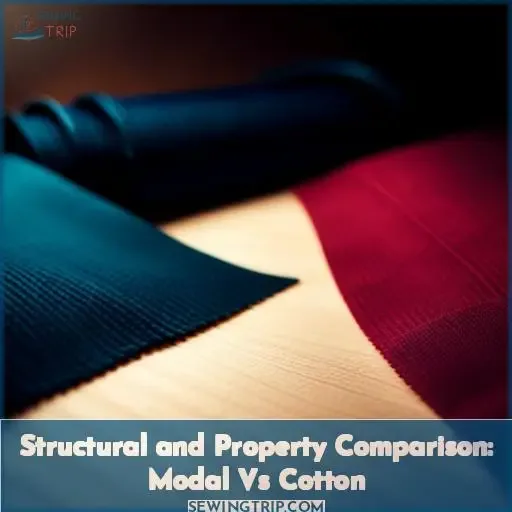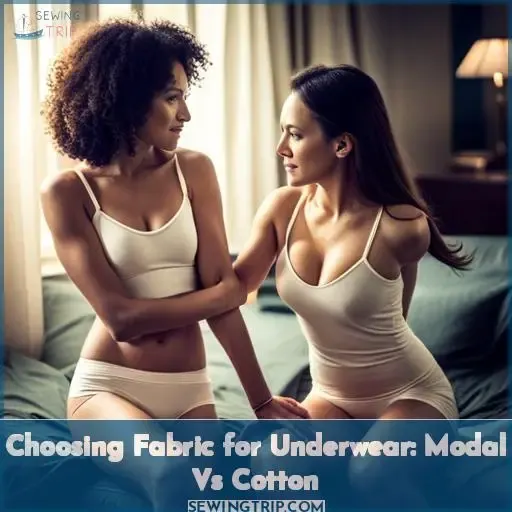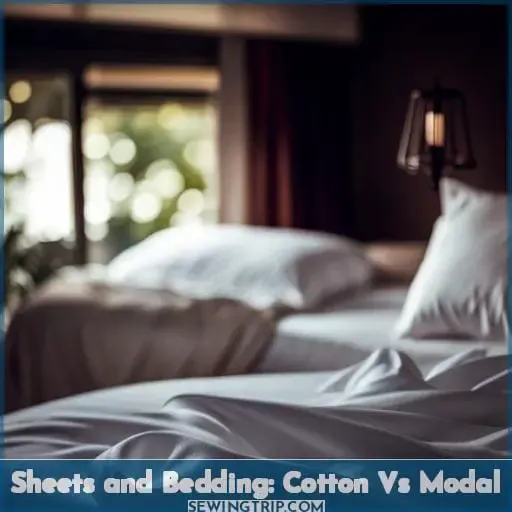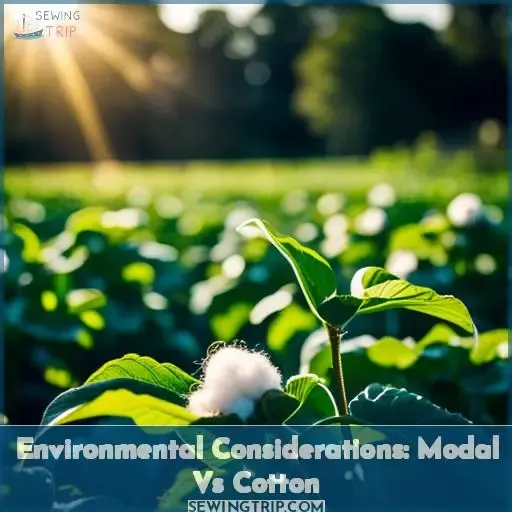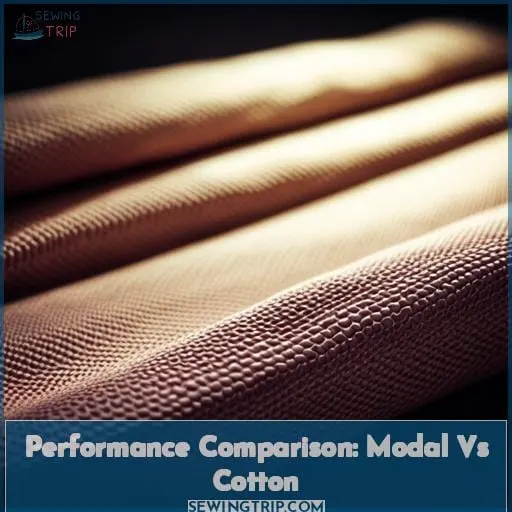This site is supported by our readers. We may earn a commission, at no cost to you, if you purchase through links.
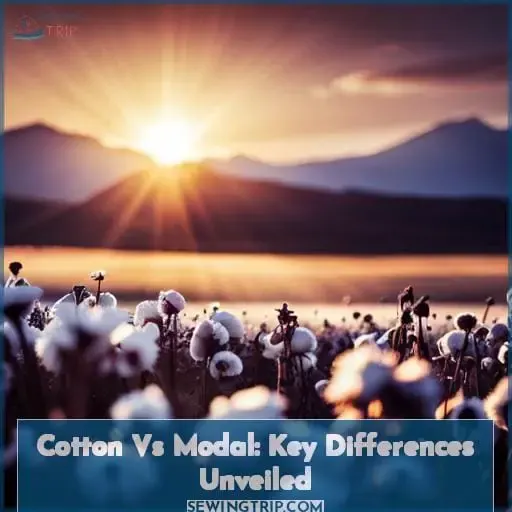
We’ll also discuss why carefully choosing either material is important for underwear or sheets and bedding.
Cotton is a natural fiber that comes from the cotton plant. It has some stretch, but not a lot, so cotton fabrics keep their shape well. Cotton is very breathable and helps absorb moisture, making it great for hot weather.
It’s also durable and can stand up to repeated washings. However, cotton wrinkles easily.
Modal is a semi-synthetic fabric made from regenerating cellulose fibers from beech trees. It is silky soft, smooth, and incredibly absorbent, taking dye colors vividly. Modal has more stretch and is more breathable than cotton due to its absorbent quality.
When choosing sheets and bedding, cotton offers durability and a crisp, classic feel. Modal sheets feel luxuriously soft and silky but may not last as long. For underwear, cotton provides breathability, while modal feels softer against the skin.
In summary, while both cotton and modal have their advantages and disadvantages, pay close attention to factors like stretch, durability, and breathability when deciding which is better for specific uses like underwear or bed sheets.
Matching the fabric properties to your preferences and needs will ensure you choose the perfect cotton or modal textile.
Table Of Contents
- Key Takeaways
- Modal Fabric Vs Cotton: Key Characteristics
- Structural and Property Comparison: Modal Vs Cotton
- Choosing Fabric for Underwear: Modal Vs Cotton
- Different Applications: Modal Vs Cotton
- Sheets and Bedding: Cotton Vs Modal
- Environmental Considerations: Modal Vs Cotton
- Performance Comparison: Modal Vs Cotton
- Cost and Budget: Modal Vs Cotton
- Conclusion
Key Takeaways
- Cotton is a natural fiber with good breathability and heat insulation, but less stretch and moisture-wicking compared to modal.
- Modal, a semi-synthetic fabric made from beech trees, provides superior stretch, moisture absorption, and quick drying properties.
- Cotton offers more durability and is more budget-friendly, whereas modal is smoother, softer on the skin, and better suited for activewear.
- When choosing between the two fabrics, consider your needs for comfort, durability, moisture-wicking, and your values regarding sustainability.
Modal Fabric Vs Cotton: Key Characteristics
When choosing between modal and cotton fabrics for men’s underwear, consider key differences in stretchability, absorbency, breathability, comfort, and durability. Modal’s superior stretch and moisture-wicking contrasts with cotton’s renowned comfort and ruggedness.
Ultimately, your personal preferences and intended uses should guide you toward the ideal fabric.
While modal offers excellent stretch and moisture-wicking properties, cotton remains revered for its exceptional comfort and durability. The optimal fabric depends on your priorities – if you desire exceptional stretch and breathability, modal excels, but cotton’s soft handfeel and ruggedness also have merit.
Carefully weigh your needs in absorbency, breathability, handfeel and intended use when selecting modal versus cotton for men’s underwear. There is no universal best, only the fabric best suited to your unique preferences and lifestyle.
Stretchability, Water Absorption, and Breathability
You’ll be amazed to learn that modal fabric can stretch up to 50% more than cotton without losing its shape, making it the superior choice for comfort and flexibility in your underwear.
- Modal absorbs 50% more moisture than cotton, keeping you drier.
- Modal is more breathable than cotton, promoting airflow and cooling.
- Modal’s moisture-wicking prevents bacteria growth like cotton can.
- Modal requires less drying time than cotton after washing.
Modal’s impressive stretchiness, moisture absorption, and breathability characteristics give it advantages over cotton for underwear and clothing.
Comfort, Durability, and Breathability
While cotton keeps you cool and cozy, its durability can’t quite match modal’s resilience over time.
| Modality | Cotton |
|---|---|
| Less prone to pilling and shrinking | More prone to pilling and shrinkage |
| Holds shape well, resists fading after washing | Can lose shape and fade over time |
| Smooth texture retains softness | Rougher weave may soften |
| Withstands daily wear and washing | Repeated washing can degrade fibers |
| Overall more durable and resilient | Overall less durable than modal |
When it comes to comfort and breathability, both fabrics score highly. But modal’s superior durability gives it an edge for underwear and other frequent-use items. Cotton remains a budget-friendly, time-tested staple though. Modal offers modern resilience.
Structural and Property Comparison: Modal Vs Cotton
When comparing modal versus cotton, there are similarities but also distinct differences in their structure, composition, and key properties. While both are naturally derived fabrics known for softness, breathability, versatility, and biodegradability, modal offers greater durability and stretch.
Structure, Composition, and Properties
- Modal is made from beech wood pulp while cotton comes from the cotton plant.
- Modal has more stretch whereas cotton has more durability.
- Modal absorbs moisture better, but cotton breathes better.
- Modal production utilizes chemicals, whereas cotton can be organic.
- Both modal and cotton have soft, breathable, and versatile fabric properties.
Similarities: Natural Origin, Breathability, Softness, Versatility, Durability, and Biodegradability
Despite late period distinctions, cotton and modal share a natural provenance, easy breathing, delicate touch, diverse application, lasting endurance, and breakdown over time.
Both cotton and modal fabrics provide similar advantages in softness, breathability, versatility, durability, biodegradability, and derivation from natural substances. Opting between the two relies on weighing elements such as stretch, moisture absorption, and pricing.
| Cotton | Modal | |
|---|---|---|
| Softness | High | High |
| Breathability | High | High |
| Biodegradability | Yes | Yes |
| Natural Origin | Yes | Yes |
| Versatility | High | High |
| Durability | High | High |
Differences: Stretchability, Water Absorption, Production Process, and Price
You’ll notice modal has more give and absorbs moisture better, though cotton remains the budget-friendly choice.
- Modal has more stretch, whereas cotton has minimal give.
- Modal absorbs 50% more moisture than cotton does.
- Modal is made from reconstituted fiber, while cotton comes from the cotton plant.
- Modal costs more as it requires more processing than cotton.
Overall, the two fabrics differ in stretchability, absorption, production methods, and price, which impacts their performance.
Choosing Fabric for Underwear: Modal Vs Cotton
When it comes to underwear, comfort and breathability are crucial. Both modal and cotton possess soft, breathable qualities that make them suitable options, but modal’s superior moisture-wicking properties give it an advantage for keeping you dry and preventing odors.
The smooth, silky texture of modal also prevents friction and irritation. While cotton is a classic choice appreciated for its natural feel, modal excels at moisture management. Its quick-drying properties also help prevent bacteria growth that leads to odors.
Ultimately, modal offers unbeatable comfort for underwear, though personal preference plays a role. Some may prefer cotton’s traditional feel. However, modal’s advanced fabric technology gives it the functional edge.
Comfort and breathability.
You’re going to feel more comfortable in cotton underwear when it’s hot out. Cotton offers superior airflow and breathability compared to modal. The loose weave of cotton fibers allows for more ventilation. This gives cotton an advantage for temperature and moisture control.
| Material | Breathability | Moisture Wicking |
|---|---|---|
| Cotton | Excellent | Poor |
| Modal | Good | Excellent |
Durability and moisture-wicking.
Though cotton is more durable, modal’s superior moisture-wicking makes it ideal for underwear.
- Modal fabric dries faster, keeping you comfortable.
- Cotton retains more moisture against your skin.
- With proper care, modal underwear can have good longevity.
Environmental considerations
Unfortunately, the modal production process requires almost triple the amount of water than conventional cotton farming does. When choosing fabric for underwear, consider the environmental impact. While conventionally produced cotton has a large footprint, organic cotton and modal made with sustainable practices by Lenzing offer eco-friendly options.
| Fabric | Water Usage | Carbon Emissions |
|---|---|---|
| Conventional Cotton | High | High |
| Organic Cotton | Low | Low |
| Lenzing Modal | Low | Low |
Different Applications: Modal Vs Cotton
When it comes to retaining moisture and heat, modal has the edge over cotton for clothing that needs to stay dry and cool against your skin. With its superior moisture management, modal pulls sweat away from your body better than cotton.
This makes it ideal for activewear and sports apparel, where moisture control and quick drying are essential for comfort.
Modal also adapts well to different clothing items. Its smooth texture and drape allow it to be used for anything from t-shirts to dress shirts. Cotton, while comfortable, absorbs and retains more moisture. It insulates heat rather than wicking it away.
Cotton works for casual wear, but for technical and performance apparel, modal’s advanced thermal properties give it an advantage.
With modal’s strength in moisture management and versatility, it’s easy to see why it’s become a go-to fiber for clothing that needs to perform.
Sheets and Bedding: Cotton Vs Modal
When it comes to sheets and bedding, both cotton and modal fabrics have advantages.
Cotton sheets tend to be cheaper, more durable, and wrinkle-resistant than modal sheets. However, modal excels in softness and feels smoother on skin. Modal sheets also shrink less than cotton.
For breathability, cotton’s the go-to. Its natural fibers allow more airflow, keeping you cooler at night. Modal doesn’t breathe as well, but this also makes it better at trapping heat in colder months.
While modal needs more delicate washing, cotton’s easier to clean and launder. Thankfully both are machine washable with care. When buying sheets, thread count matters more than material. Aim for at least 200 threads per inch for softness.
Ultimately, personal preference rules. Seek organic, sustainable cotton or eco-friendly modal for the most responsible choice.
Environmental Considerations: Modal Vs Cotton
When choosing between modal and cotton for fabrics, it’s important to consider the environmental impact. The production of modal requires more chemicals than cotton. However, conventional cotton farming uses enormous amounts of water and pesticides, while organic cotton reduces that impact through sustainable farming methods.
Lenzing Modal aims to offset its chemical processing impacts through sustainable forestry practices.
Environmental Impact of Modal Fabric Production
You’ve got to admit, the manufacturing process for modal fabric ain’t exactly gentle on the environment.
| Modal | Cotton |
|---|---|
| High water usage | High pesticide usage |
| Uses hazardous chemicals | Depletes soil health |
| Lenzing pursuing sustainability | Organic cotton options exist |
The modal production process can improve. However, both fabrics have environmental impacts worth weighing.
Environmental Impact of Conventionally Produced Cotton
Unfortunately, most cotton grown today relies heavily on pesticides and insecticides that pollute our waterways.
- Conventional cotton uses an immense amount of water.
- It is often genetically modified and sprayed with dangerous chemicals.
- The chemicals contaminate nearby ecosystems.
- Pesticides harm cotton farmworkers and surrounding communities.
- Conventional cotton depletes and degrades soil.
Organic cotton limits environmental damage by avoiding synthetic chemicals and genetically modified seeds. It is a more eco-friendly alternative. Although costlier, it is gentler on the planet. We must weigh expenses against long-term sustainability. With mindful buying, we can nurture Earth while enjoying cotton’s benefits.
Organic Cotton as an Eco-Friendly Option
You can choose organic cotton as a greener alternative. Organic cotton is grown without pesticides or chemicals. This supports sustainable farming and preserves soil health. Organic cotton’s environmental impact is much lower than conventional cotton.
Conventional Cotton Organic Cotton
Farming Methods Uses pesticides and chemicals. Hard on soil. Grown without pesticides or chemicals.
Water Usage Requires heavy irrigation. Strains water resources. Uses rainwater. Reduces dependence on irrigation.
Carbon Emissions Significant emissions from chemical fertilizers. Minimal emissions without chemical fertilizers.
Environmental Impact High impact due to pesticides, chemicals, water use. Low impact with no pesticides or chemicals.
Consumer Choice Less eco-friendly option. Excellent eco-friendly choice. Supports sustainable agriculture.
Price Cheaper than organic cotton. More expensive than conventional cotton. Worth it for environmental benefits.
Availability Readily available. Most cotton produced conventionally. Less available.
Lenzing Modal’s Sustainable Practices
It’s remarkable how Lenzing Modal is leading the way with sustainable practices like closed-loop production and responsible forestry.
- Their certified, safe harvesting of beechwood shows a commitment to responsible sourcing.
- They utilize eco-friendly manufacturing processes that minimize environmental impact.
- The renewably sourced raw materials demonstrate their dedication to sustainability.
Lenzing Modal sets a shining example of environmental responsibility in fabric production. In comparison to conventional cotton, their modal offers a far more sustainable alternative. Their efforts to operate conscientiously makes them a role model in the industry.
Performance Comparison: Modal Vs Cotton
When comparing the performance of modal versus cotton, there are some key differences to consider. Modal has greater breathability and water absorption, while cotton provides more durability and softness.
The modal fabric offers exceptional breathability, rapidly absorbing and evaporating perspiration. This results in a cooler, drier wearing experience compared to cotton. Modal also readily absorbs moisture, whether from sweat or spills.
Cotton’s strength lies in its natural softness and excellent durability. The fibers resist pilling and abrasion, maintaining their smooth handfeel through extended wear and washing. Cotton also gets softer over time. These characteristics make cotton garments comfortable and long-lasting.
In summary, modal excels at moisture management while cotton provides exceptional comfort and longevity. Understanding these trade-offs allows consumers to select the best fabric for their needs.
Breathability: Cotton Vs Modal
Cotton’s superior breathability makes it the better underwear fabric for moisture management, hot weather, athletic use, and overall airflow compared to modal.
| Cotton | Modal | |
|---|---|---|
| Moisture Wicking | Excellent | Good |
| Hot Weather Performance | Better | Good |
| Athletic Use | Preferred | Good |
| Overall Breathability | Superior | Very Good |
Durability: Modal Vs Cotton
While cotton underwear may outlast modal, modal’s silky-smooth feel against the skin outweighs marginal durability concerns for most. Though cotton shows greater endurance over repeated use and washing, modal offers a luxurious softness that makes durability a secondary consideration.
The supple handfeel of modal is seductive, transcending mundane fabric longevity.
Water Absorption: Modal Vs Cotton
You’ll be impressed at how modal absorbs sweat from your skin, unlike cotton which gets soaked through and takes ages to dry. The hygroscopic nature of modal fiber rapidly absorbs moisture, transporting it through the fabric so your skin stays dry.
Cotton retains more water internally, requiring longer drying times. For active pursuits and hot, humid climates, modal underwear excels at moisture wicking compared to standard cotton.
Softness: Modal Vs Cotton
You’d love the extra-soft feel of modal against your skin.
- Ultra-fine fibers create modal’s silky softness.
- Cotton can feel coarser, especially at lower thread counts.
- Modal’s smooth texture is appealing if you have sensitive skin.
- Perceptions of softness also depend on personal preferences.
Cost and Budget: Modal Vs Cotton
When deciding between modal and cotton for your underwear, the cost is an important factor to consider. Cotton is typically more budget-friendly, with lower priced options widely available.
Price Comparison
Cost shocks: Modal can triple your underwear budget.
| Fabric | Price per Yard |
|---|---|
| Modal | $20 – $40 |
| Cotton | $5 – $15 |
Going modal may blow your budget, but many find it worthwhile for the softness. Seek sales or cheaper modal blends. Or try budget-friendly cotton from sustainable sources like organic or recycled. Your values and preferences are what matter most when choosing fabrics. Comfort trumps cost for some.
Budget-Friendly Cotton Options
Although modal usually costs more, cotton can be quite budget-friendly if you look for sales or generic brands.
- Look for cotton items that are on sale or clearance.
- Shop at discount stores like TJ Maxx or Marshalls.
- Opt for store brand cotton products rather than name brands.
- Buy cotton sheets and clothing during the off-season when prices are lower.
- Choose a cotton-polyester blend to reduce the overall cost.
- Consider purchasing secondhand cotton pieces from thrift stores.
Conclusion
Both modal and cotton fabrics have their own distinct advantages. From breathability to comfort and durability, there’s much to like about both fabrics. However, there are some key differences that can help you decide which fabric works best for your needs.
Modal is known for its stretchability, superior water absorption, and breathability. Cotton, on the other hand, is known for its comfort, durability, and breathability.
Furthermore, when it comes to choosing fabrics for underwear, modal offers more moisture-wicking properties than cotton, making it a better choice if moisture control is a priority.
Ultimately, understanding the key differences between modal and cotton can help you make the best decision for your needs.

